|
AUTOZINE TECHNICAL SCHOOL
Steering Electric
Power Steering
Introduction Steering is very important to a car because it is the interface that the driver touches most. What makes a car's steering better than another? It is usually judged by several factors: directness, weighting and feel. Unfortunately, these factors usually contradict with each other. A steering geared too fast could be too heavy for the driver to handle. A steering too hefty may also mask the tactile signals transmitted from the front tires to your hands. Everybody wants the unassisted steering of Lotus Elise, which is just fast enough, light enough yet very feelsome. Unfortunately, unassisted steering is no longer possible on 99 percent of modern cars. Increased weight, front-biased weight distribution and wider front tires mean the steering has more resistance to fight against, thus power steering becomes inevitable. Admittedly, this has been the case for many decades. Automotive engineers developed hydraulic-assisted steering to solve the problem without robbing steering feel too much. It is perfectly acceptable. However, entering the new millenium, hydraulic power steering has been seriously challenged by the call for reducing emission. The hydraulic pump of power steering is driven directly by the engine, so it works not only all the time but also unnecessarily hard at high rev. According to some studies, it acounts for 4 percent of the car's fuel consumption. From the mid-2000s, many car makers turned to electrohydraulic power steering, which replaces the engine-driven pump with an electric pump that works on demand. This halves the power consumption without compromising steering quality. However, when governments imposed tougher emission/fuel economy standards, electrohydraulic steering has to give way to more efficient, full electric power steering (EPS), which consumes only a tenth of the power of hydraulic power steering. Even dedicated sports cars like Porsche could not resist the trend. Why is EPS so energy efficient? Apart from the fact that electric motor is inherently efficient, EPS saves energy because it provides assistance only when you turn the steering wheel either sides. On the straight ahead, it is left in stand-by thus consumes vitually no power. On the downside, EPS is difficult, if not impossible, to mimic the tactile feel of hydraulic power steering. At the time of writing, even the best EPS examples of Porsche fail to deliver the same connection as their hydraulic predecessors. The working principle of EPS is simple: 1. Sensors at the steering column detect the steering angle and torque; 2. ECU analyses the signals and determines the amount of assistance necessary; 3. An electric motor mounted at the steering column or rack actuates the assistance force according to the instruction of ECU. Depending on the actuating mechanism, there are several types of EPS widely used on production cars: Column EPS Column type EPS has the longest history. In fact, the world's first EPS introduced to Suzuki Cervo in 1988 was this type, although that one worked only as parking assistance. In column EPS, the motor is mounted at the steering column and drives the steering shaft directly. Its advantage is simple construction and low cost. Since the motor is located inside the dashboard, it is not subjected to water and extreme temperatures, thus the production cost could be lowered further. On the downside, column EPS is notorious for numb feel, because the direct connection of motor to the steering column increases mechanical friction. Moreover, since the motor is mounted at the top of the steering shaft, the latter and its universal joints have to be strengthened to avoid twisted by the torque of motor. This increases inertia, friction hence numbness further. The heavier the front-axle load, the more serious this problem becomes. For these reasons, column EPS is usually reserved for cheap small cars. 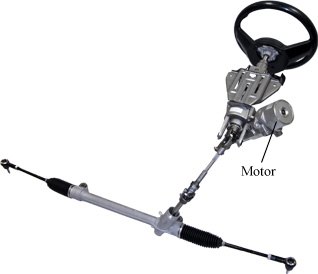 Single-Pinion EPS Single-pinion EPS has the motor force applied directly to the pinion gear on steering rack. It should give better feel than column type, but it has one serious disadvantage: since the motor is located just in front of the pedals, in the event of front-end collision the motor is likely to be pushed against the driver's legs and cause injuries. Due to this safety drawback, many manufacturers have turned to dual-pinion system. 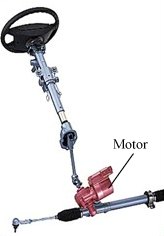 Dual-Pinion EPS Dual-pinion EPS adds a second pinion gear to the steering rack. The electric motor drives this additional pinion. Since the motor is mounted far away from the steering column, the risk of leg injuries in collision could be largely reduced. Moreover, by decoupling the motor from the steering column, steering feel could be improved. 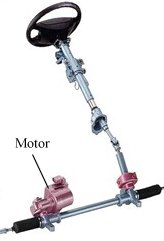 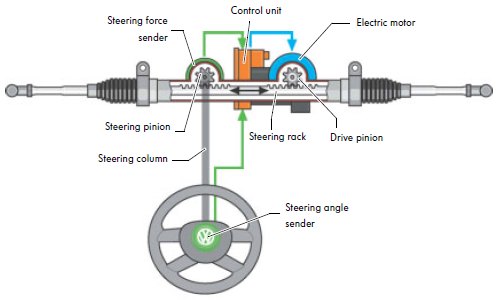 The first mass production dual-pinion EPS was developed by ZF and applied to Volkswagen Golf V platform from 2003, then extended to Passat and many other manufacturers. Today, most of the best driving C-segment cars employ this type of EPS. Nevertheless, it is not powerful enough to handle heavier vehicles. Parallel Axis EPS Parallel Axis EPS is more expensive than all the above types, but it is also more powerful and precise, so it is widely used by large luxury cars, premium cars emphasizing dynamics as well as sports cars, including Porsche 991. 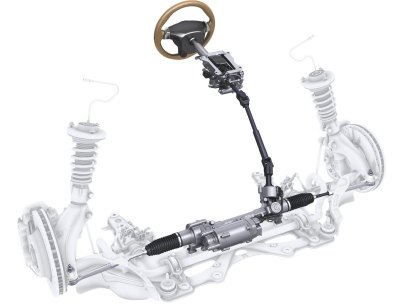 The ZF Parallel Axis EPS of Porsche 991 The electric motor is mounted in parallel to the steering rack. It drives the steering rack through a toothed belt and a step-down gearbox. 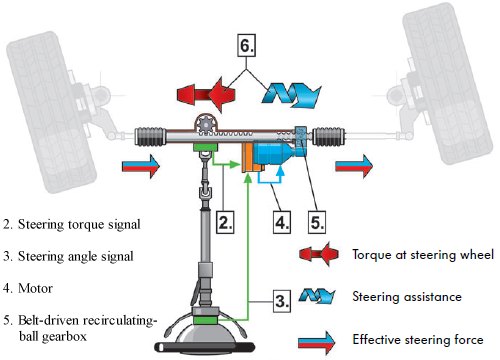 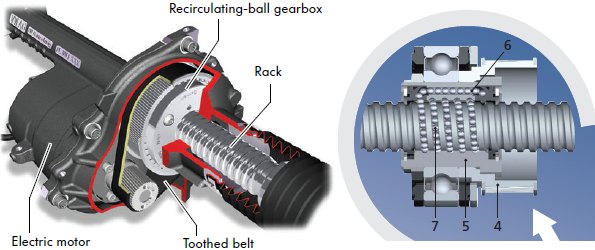 The gearbox transfers rotational motion to axial motion through many ball bearings, which run around the grooves on the steering rack. When the balls exit from one end, they recirculate back to the front through a special channel. Such construction is similar to conventional recirculating-ball steering. Thanks to these ball bearings, friction is kept to the minimum. It goes without saying the less friction it added to the system, the more true information can be transferred to your hands. Therefore, parallel axial EPS should be more feelsome. Moreover, thanks to the step-down gearbox, the motor drive can be controlled more precisely. |
||

|
||
| Copyright© 1997-2016 by Mark Wan @ AutoZine |